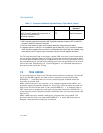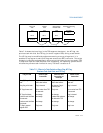
Vol. 3 7-17
TASK MANAGEMENT
Table 7-2 shows the busy flag (in the TSS segment descriptor), the NT flag, the
previous task link field, and TS flag (in control register CR0) during a task switch.
The NT flag may be modified by software executing at any privilege level. It is
possible for a program to set the NT flag and execute an IRET instruction. This might
randomly invoke the task specified in the previous link field of the current task's TSS.
To keep such spurious task switches from succeeding, the operating system should
initialize the previous task link field in every TSS that it creates to 0.
Figure 7-8. Nested Tasks
Table 7-2. Effect of a Task Switch on Busy Flag, NT Flag,
Previous Task Link Field, and TS Flag
Flag or Field Effect of JMP
instruction
Effect of CALL
Instruction or
Interrupt
Effect of IRET
Instruction
Busy (B) flag of new
task.
Flag is set. Must have
been clear before.
Flag is set. Must have
been clear before.
No change. Must have
been set.
Busy flag of old task. Flag is cleared. No change. Flag is
currently set.
Flag is cleared.
NT flag of new task. Set to value from TSS
of new task.
Flag is set. Set to value from TSS
of new task.
NT flag of old task. No change. No change. Flag is cleared.
Previous task link field
of new task.
No change. Loaded with selector
for old task’s TSS.
No change.
Previous task link field
of old task.
No change. No change. No change.
TS flag in control
register CR0.
Flag is set. Flag is set. Flag is set.
Top Level
Task
NT=0
Previous
TSS
Nested
Tas k
NT=1
TSS
More Deeply
Nested Task
NT=1
TSS
Currently Executing
Task
NT=1
EFLAGS
Task Register
Task Link
Previous
Task Link
Previous
Task Link


















